Crystal habit
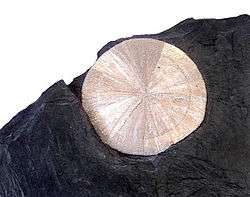
In mineralogy, crystal habit is the characteristic external shape of an individual crystal or crystal group. A single crystal's habit is a description of its general shape and its crystallographic forms, plus how well developed each are. Recognizing the habit may help in identifying a mineral. When the faces are well-developed due to uncrowded growth a crystal is called euhedral, one with partially developed faces is subhedral, and one with undeveloped crystal faces is called anhedral. The long axis of a euhedral quartz crystal typically has a six-sided prismatic habit with parallel opposite faces. Aggregates can be formed of individual crystals with euhedral to anhedral grains. The arrangement of crystals within the aggregate can be characteristic of certain minerals. For example, minerals used for asbestos insulation often grow in a fibrous habit, a mass of very fine fibers.[1][2]
The terms used by mineralogists to report crystal habits describe the typical appearance of an ideal mineral. Recognizing the habit can aid in identification as some habits are characteristic. Most minerals, however, do not display ideal habits due to conditions during crystallization. Euhedral crystals formed in uncrowded conditions with no adjacent crystal grains are not common; more often faces are poorly formed or unformed against adjacent grains and the mineral's habit may not be easily recognized.[1]
Factors influencing habit include: a combination of two or more crystal forms; trace impurities present during growth; crystal twinning and growth conditions (i.e., heat, pressure, space); and specific growth tendencies such as growth striations. Minerals belonging to the same crystal system do not necessarily exhibit the same habit. Some habits of a mineral are unique to its variety and locality: For example, while most sapphires form elongate barrel-shaped crystals, those found in Montana form stout tabular crystals. Ordinarily, the latter habit is seen only in ruby. Sapphire and ruby are both varieties of the same mineral; corundum.
Some minerals may replace other existing minerals while preserving the original's habit: this process is called pseudomorphous replacement. A classic example is tiger's eye quartz, crocidolite asbestos replaced by silica. While quartz typically forms prismatic (elongate, prism-like) crystals, in tiger's eye the original fibrous habit of crocidolite is preserved.
The names of crystal habits are derived from:
Predominant crystal faces (prism – prismatic, pyramid – pyramidal and pinacoid – platy). Crystal forms (cubic, octahedral, dodecahedral). Aggregation of crystals or aggregates (fibrous, botryoidal, radiating, massive). Crystal appearance (foliated/lamellar (layered), dendritic, bladed, acicular, lenticular, tabular (tablet shaped)).
List of crystal habits
| Habit[3][4][5] | Image | Description | Common Example(s) |
|---|---|---|---|
| Acicular | 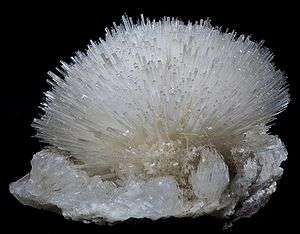 |
Needle-like, slender and/or tapered | Natrolite, Rutile[6] |
| Amygdaloidal | Almond-shaped | Heulandite, subhedral Zircon | |
| Bladed | Blade-like, slender and flattened | Actinolite, Kyanite | |
| Botryoidal or globular | 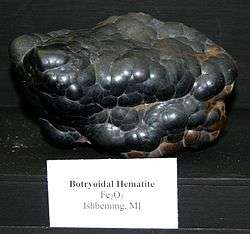 |
Grape-like, hemispherical masses | Hematite, Pyrite, Malachite, Smithsonite, Hemimorphite, Adamite, Variscite |
| Columnar |  |
Similar to fibrous: Long, slender prisms often with parallel growth | Calcite, Gypsum/Selenite |
| Coxcomb |  |
Aggregated flaky or tabular crystals closely spaced. | Barite, Marcasite |
| Cubic | 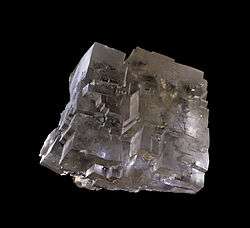 |
Cube shape | Pyrite, Galena, Halite |
| Dendritic or arborescent |  |
Tree-like, branching in one or more direction from central point | Romanechite and other Mn-oxide minerals, magnesite, native copper |
| Dodecahedral | 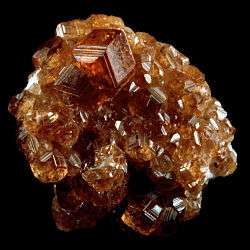 |
Rhombic dodecahedron, 12-sided | Garnet |
| Drusy or encrustation |  |
Aggregate of minute crystals coating a surface or cavity | Uvarovite, Malachite, Azurite |
| Enantiomorphic |  |
Mirror-image habit (i.e. crystal twinning) and optical characteristics; right- and left-handed crystals | Quartz, Plagioclase, Staurolite |
| Equant, stout | 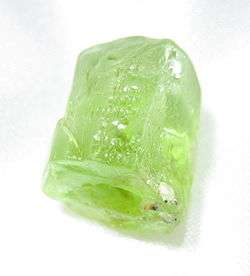 |
Length, width, and breadth roughly equal | Olivine, Garnet |
| Fibrous | 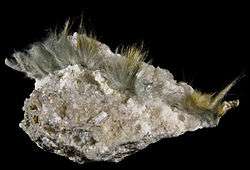 |
Extremely slender prisms | Serpentine group, Tremolite (i.e. Asbestos) |
| Filiform or capillary |  |
Hair-like or thread-like, extremely fine | many Zeolites |
| Foliated or micaceous or lamellar (layered) |  |
Layered structure, parting into thin sheets | Mica (Muscovite, Biotite, etc.) |
| Granular | 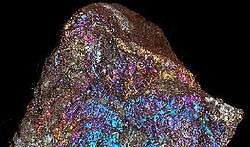 |
Aggregates of anhedral crystals in matrix | Bornite, Scheelite |
| Hemimorphic |  |
Doubly terminated crystal with two differently shaped ends. | Hemimorphite, Elbaite |
| Hexagonal | Hexagon shape, six-sided | Quartz, Hanksite | |
| Hopper crystals |  |
Like cubic, but outer portions of cubes grow faster than inner portions, creating a concavity | Halite, Calcite, synthetic Bismuth |
| Mammillary | .jpg) |
Breast-like: surface formed by intersecting partial spherical shapes, larger version of botryoidal, also concentric layered aggregates | Malachite, Hematite |
| Massive or compact |  |
Shapeless, no distinctive external crystal shape | Limonite, Turquoise, Cinnabar, Realgar |
| Nodular or tuberose | Deposit of roughly spherical form with irregular protuberances | Chalcedony, various Geodes | |
| Octahedral | 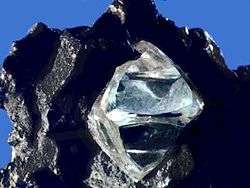 |
Octahedron, eight-sided (two pyramids base to base) | Diamond, Magnetite |
| Plumose | 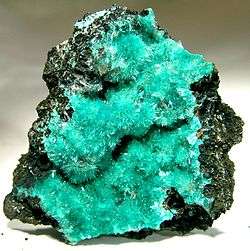 |
Fine, feather-like scales | Aurichalcite, Boulangerite, Mottramite |
| Prismatic | 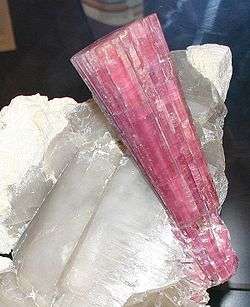 |
Elongate, prism-like: crystal faces parallel to c-axis well-developed | Tourmaline, Beryl |
| Pseudo-hexagonal | 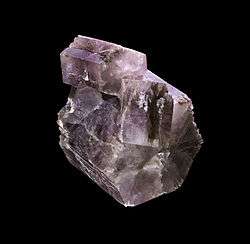 |
Hexagonal appearance due to cyclic twinning | Aragonite, Chrysoberyl |
| Radiating or divergent |  |
Radiating outward from a central point | Wavellite, Pyrite suns |
| Reniform or colloform |  |
Similar to botryoidal/mamillary: intersecting kidney-shaped masses | Hematite, Pyrolusite, Greenockite |
| Reticulated |  |
Crystals forming net-like intergrowths | Cerussite |
| Rosette or lenticular (lens shaped crystals) | 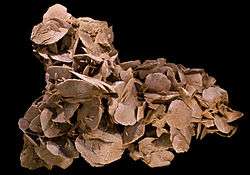 |
Platy, radiating rose-like aggregate | Gypsum, Barite (i.e. Desert rose) |
| Sphenoid | 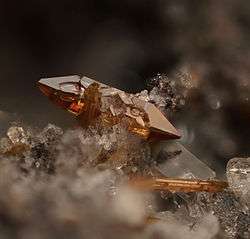 |
Wedge-shaped | Sphene |
| Stalactitic |  |
Forming as stalactites or stalagmites; cylindrical or cone-shaped | Calcite, Goethite |
| Stellate | 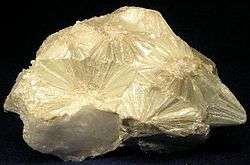 |
Star-like, radiating | Pyrophyllite, Aragonite |
| Striated |  |
Not a habit per se, but a condition of lines that can grow on certain crystal faces on certain minerals | Tourmaline, Pyrite, Quartz, Feldspar, Sphalerite |
| Stubby or blocky or tabular | 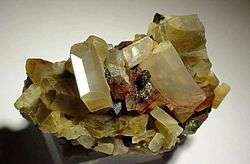 |
More elongated than equant, slightly longer than wide, flat tablet shaped | Feldspar, Topaz |
| Platy | 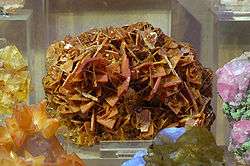 |
Flat, tablet-shaped, prominent pinnacoid | Wulfenite |
| Tetrahedral |  |
Tetrahedra-shaped crystals | Tetrahedrite, Spinel, Magnetite |
| Wheat sheaf | 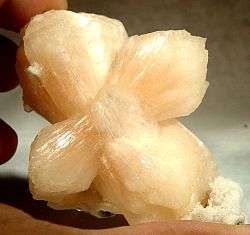 |
Aggregates resembling hand-reaped wheat sheaves | Stilbite |
See also
References
- 1 2 Klein, Cornelis, 2007, Minerals and Rocks: Exercises in Crystal and Mineral Chemistry, Crystallography, X-ray Powder Diffraction, Mineral and Rock Identification, and Ore Mineralogy, Wiley, third edition, ISBN 978-0471772774
- ↑ Wenk, Hans-Rudolph and Andrei Bulakh, 2004, Minerals: Their Constitution and Origin, Cambridge, first edition, ISBN 978-0521529587
- ↑ What are descriptive crystal habits
- ↑ Crystal Habit
- ↑ Habit
- ↑ Hanaor, D.A.H; Xu, W; Ferry, M; Sorrell, CC (2012). "Abnormal grain growth of rutile TiO2 induced by ZrSiO4". Journal of Crystal Growth. 359: 83–91. doi:10.1016/j.jcrysgro.2012.08.015.